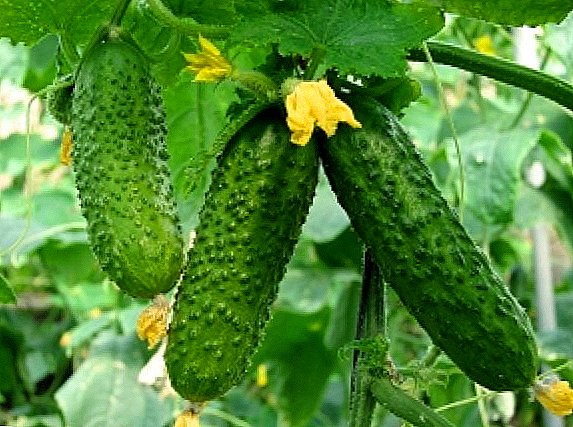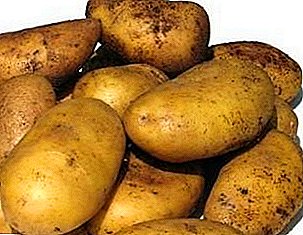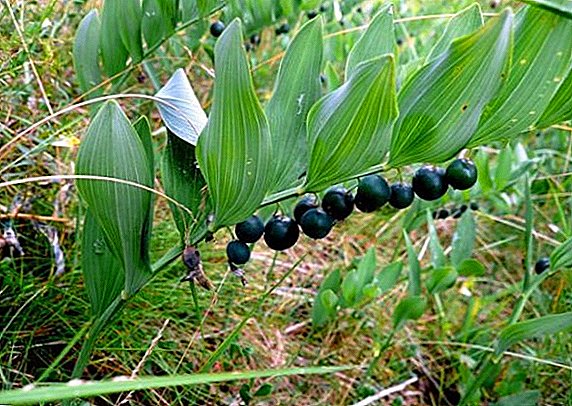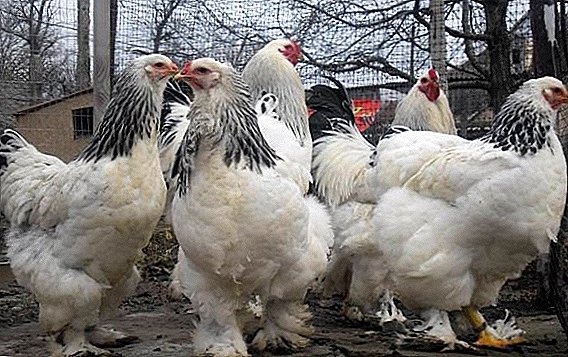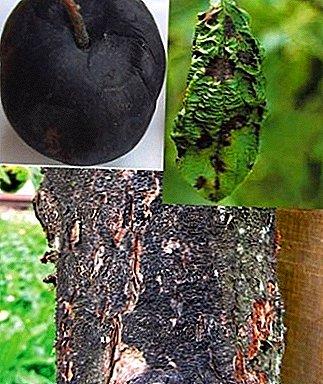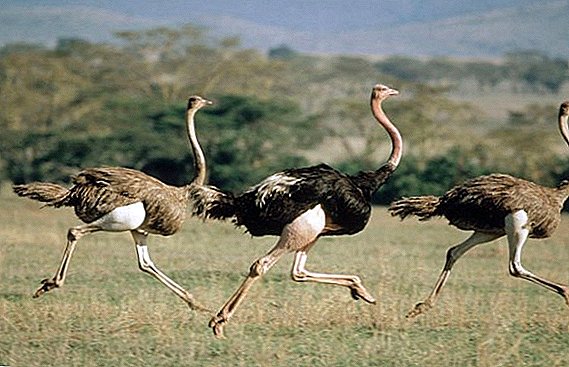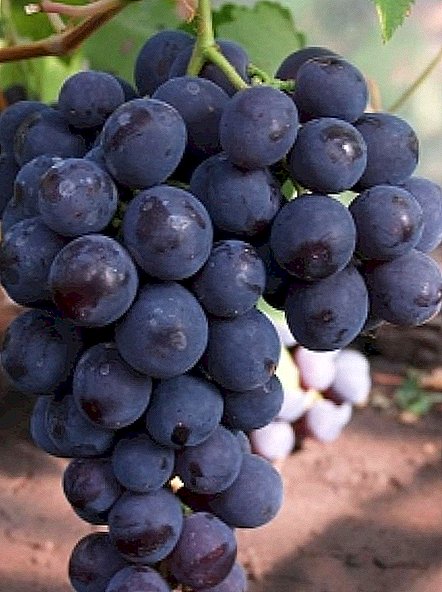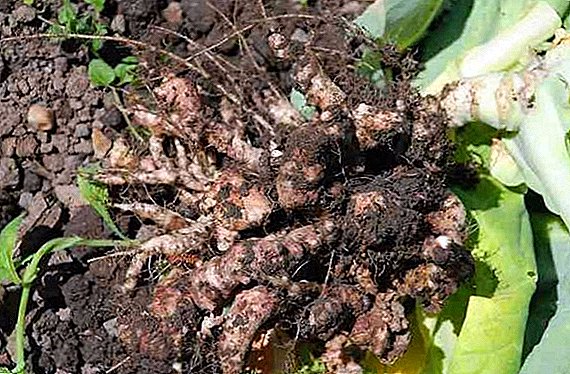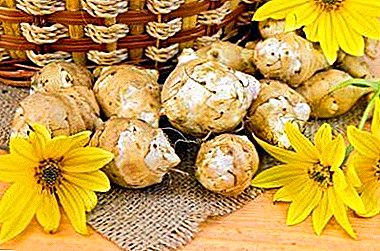
Jerusalem artichoke (earth pear) is a useful, high-yielding, unpretentious plant, the tubers of which can be used as food, and the green mass for pet food.
To get a good harvest of Jerusalem artichoke, you need to remember that this plant can be grown in one place for many years, which will not affect the yield and quality of the soil, but the area should be taken away well lit and remote from other plants, as this giant can displace other culture; it has a high frost resistance, is not picky about the soil (any soil is suitable, except for acidifying soils), tolerates drought well, but with excessive moisture it rots.
How to grow an earthen pear from tubers and seeds and where to get them, as well as what is needed to grow it at home and how to properly grow a plant on the plot in the country to get a good harvest. This and much more will be described in our article.
How to choose the right grade?
To choose the right variety of Jerusalem artichoke, you need to see the purpose of growing this plant:
- as a remedy;
- breed as an element of landscape design;
- for human use in food or livestock feed.
Almost all varieties of Jerusalem artichoke in modern breeding are aimed at obtaining both abundant above-ground parts of the plant, and a large number of tubers from the bush. Dietary varieties have been developed, the distinguishing feature of which is increased tuberization and a small green mass.
Each variety has its own characteristics, which can be found in the table.
| Grade name | The yield of tubers per square meter | Green mass yield from one bush | Maturing period, the growing season |
| Interest (suitable for mechanized cleaning) | 2.6-3.8 kg | 4.3-5.6 kg | Late-ripening, does not have time to mature in the Middle Band |
| Omsk white | 4.3 kg | 3 - 3.5 kg | Mid-season (130 days) |
| Pasko | 3 kg | 3, 4 kg | Late (178-190 days) |
| Early on (suitable for mechanized cleaning) | 2.5 - 3 kg | 3-3.5 kg | Early (120 days), suitable for cultivation in the middle zone |
| Solar | 4 kg | 3.1 kg | Mid-season (152-172 days) |
| Volzhsky 2 (suitable for mechanized cleaning) | 1, 5 kg | 2 kg | Early (100 days) |
| Vylgothic | 1-1.7 kg | 3, 4-4,1 kg | Early (125 days) |
| Leningrad | 4.5 -4.9 kg | 4-4.2 kg | Mid ripening (140 days) |
Comparative analysis of varieties showed that currently Omsk white and Leningradsky are among the best varieties, as they are suitable for widespread cultivation and give a high yield of both tubers and green mass.
A photo
The photo shows what the Jerusalem artichoke looks like.




Where and for how much seed can be purchased?
In each region there are companies, private entrepreneurs, topinambour lovers who are engaged in plant breeding and offer planting material for sale. Offers for sale easy to find on the Internet.
For example, the company "Ryazan spaces" from the city of Sapozhok of the Ryazan region sells Jerusalem artichoke in a package of 30 kg, the price ranges from 5 to 15 rubles per kilogram. In Moscow, planting material of Jerusalem artichoke can be purchased at prices ranging from 27 to 35 rubles per kilogram (Gorobets AV, IP, Starominskaya. Cheerful Kryska, IP, Moscow). In St. Petersburg - the cost of a pear from 25 to 150 rubles per kilogram (the order is taken from 10 kg), the plant is sold by the company "Nation's Health".
Growing ground in the open ground on the site
Landing of Jerusalem artichoke can be carried out in open ground and at home in containers. Mostly, the plant is planted in open ground because of a powerful bush. How to multiply? The earth pear can be propagated in two ways.:
- vegetative (tubers, its parts or eyes);
- generative (seeds, a long way, painstaking, requiring special knowledge).
The plant can be planted in the fall (better in the southern regions of the country) 10-15 days before the onset of frost and in spring, when the soil warms to 16-18 degrees.
Tubers
How to grow a ground pear tubers in the open field?
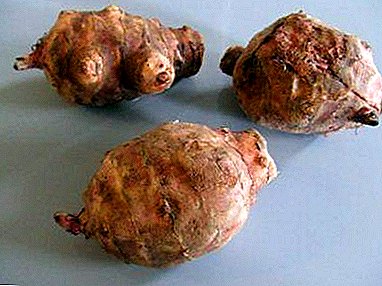 Choose a well-lit, dry place to prevent tubers from rotting.
Choose a well-lit, dry place to prevent tubers from rotting.- Prepare the garden bed by digging it onto the spade bayonet and adding compost or rotted manure.
- Before planting apply phosphorus-potassium fertilizers.
- Select large, healthy tubers (6-8 cm), without rot and damage, with several buds.
- Sprout the planting material with any immunocytophytic solution that protects against disease and accelerates growth.
- Make furrows on the ridge and plant tubers at a distance of at least 40 cm from each other, submerging them in the soil by 7-15 cm, depending on the size of the tuber. Grown with a row spacing - 60-70 cm
- After the sprouts appear, weed the bed and loosen it well. Do this procedure three times with an interval of 2 weeks.
- Thin the plants when their height reaches 10 cm: the minimum distance between the plants is 45 cm, between the rows - 30 cm.
- Spud shoots when they reach 20 cm in height, and feed urea. (In the middle of summer you can re-hilling and mulching with humus or last year’s manure).
- Tie up plants that have reached a meter height to strong supports.
- To increase the yield, cut off flowering buds or cut bushes up to 1.5 meters in height.
Growing up as a business
Currently, Jerusalem artichoke remains in the shadow of other crops, although its biochemical data and yield is much higher than that of the usual plants. The profitability of growing pear trees exceeds 300% with minimal cost. For example, economists have found that in order to develop a new topinambur plantation with an area of 50 hectares, 812 million rubles will be required. This is an approximate cost of cultivation. This amount includes the costs for the purchase of agricultural machinery, the purchase of seed, organic and mineral fertilizers, the cost of fuel and electricity.
Of course, the revenue from the sale of green mass and fresh Jerusalem artichoke tubers directly depends on the yield and the unit price. But even with the minimum yield of green mass and tubers (within the limits of 20 t / ha) the return on capital investments will come in the first year of cultivation of the Jerusalem artichoke. A plant can produce green mass up to 1000 kg / ha, tubers - 400 kg / ha!
Cultivation and reproduction of Jerusalem artichoke on an industrial scale is very profitable. Agrotechnical cultivation is similar to the technology of growing potatoes:
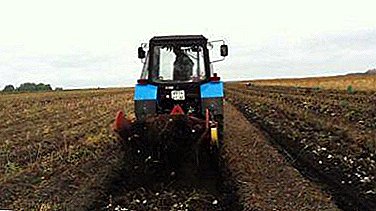 Deep autumn plowing under the Jerusalem artichoke is required.
Deep autumn plowing under the Jerusalem artichoke is required.- It is necessary to apply organic fertilizers, which are buried in the soil in autumn or spring, depending on the time of planting tubers.
- It is advisable to grow an earthen pear on the ridges, so that under unfavorable climatic conditions the tuberous nest does not freeze and does not impair the development of the plant.
- Reproduction of Jerusalem artichoke in industrial sizes is made only by tubers. The rate of planting per 1 ha depends on the planting pattern and size of planting tubers. On average, 1-1.2 tons of tubers are planted per hectare. If you need to get a large tuber harvest, then the landing should be less often (90x25 cm), if you need more green mass, then make a compacted landing in the rows and reduce the width of the row spacing to 70 or 60 cm.
- In order to prevent the development of weeds, before the emergence of shoots it is recommended to carry out a single or double harrowing.
- After emergence of shoots, it is recommended to cultivate between rows and harrowing. Further care of the plantations of the first year of planting consists in loosening the spacing and destroying weeds in the rows.
For the cultivation of the earth pears on an industrial scale need a tractorto cultivate the land, and the potato harvester for the harvest. The number of jobs will depend on the number of units of equipment, and one worker can be involved in several processes carried out in different periods of plant development.
To register a legal entity to create your own business, you need:
- invent the company name of the company, not contrary to the law;
- determine the legal address;
- select OKVED codes;
- decide on the amount of share capital;
- draw up the decision of the founder or the minutes of the general meeting and the agreement on the establishment of the LLC;
- prepare the charter of the organization;
- write an application for state registration;
- pay a state fee (4000 rubles);
- submit all documents to your tax inspectorate.
We offer to watch the video, where pre are presented ideas for business in the cultivation of Jerusalem artichoke:
Errors and solutions
| Errors | Ways to overcome mistakes |
| Thickened planting, which leads to a decrease in the yield of tubers | Thinning plantings that have reached a height of 10 cm. |
| A dense airtight crust formed on the soil surface. | Gentle loosening in accordance with the ridges in which the landing is located. |
| Landings do not water | Topinambur shrubs need abundant watering at least 1 time per month. |
| Plants do not feed | Topinambur feeding should be carried out 2-3 times. In early spring and in the second half of summer:
|
| In the autumn the aboveground part of the plant is cut. | In the autumn, the above-ground part is not cut until harvesting, as it promotes the accumulation of nutrients in the tubers, which are left in the ground for the next year. |
Harvesting
 Harvesting ground pears produced, depending on the variety, from September to November. Before cleaning, cut the tops at a height of 15-17 cm. When digging the fruits are selected the largest tubers, then they need to be washed, dried, layered, sprinkled with wet sand or sawdust, and kept in a cool basement, observing storage conditions: 85-95% humidity and temperature +4 degrees.
Harvesting ground pears produced, depending on the variety, from September to November. Before cleaning, cut the tops at a height of 15-17 cm. When digging the fruits are selected the largest tubers, then they need to be washed, dried, layered, sprinkled with wet sand or sawdust, and kept in a cool basement, observing storage conditions: 85-95% humidity and temperature +4 degrees.
Tubers of Jerusalem artichoke can be stored on a warmed balcony, in a refrigerator, but the storage periods are small - 2-3 weeks. About a year, sliced fruits can be stored in dried form.
Diseases and pests
This plant is little susceptible to diseases and pests. But in the dry or cool and rainy summer it can get sick:
- white rot (on the stems felt bloom, turning into growths of black color);
- Alternaria (leaves are covered with dark brown spots, and then the plant dries out);
- powdery mildew (leaves are covered gradually with a brownish friable white bloom).
There are two ways to combat these diseases: cutting and burning plants or once or twice processing plants with fungicides in warm weather.
Eartha pear can harm:
- moles;
- mice;
- Bears;
- slugs;
- scoops;
- May beetles and their larvae.
To combat them, you can use a concentrated soap solution, infusion of garlic. Slugs need to be assembled by hand or laid out between the rows of the trap.
The amazing plant of Jerusalem artichoke gradually conquers the fields of our country, and its unpretentiousness, resistance to diseases and high yields will provide the plant in the near future high demand.


 Choose a well-lit, dry place to prevent tubers from rotting.
Choose a well-lit, dry place to prevent tubers from rotting. Deep autumn plowing under the Jerusalem artichoke is required.
Deep autumn plowing under the Jerusalem artichoke is required.